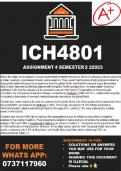3
Want to earn
Distribution of this document is illegal
R13,625 per year?
,ICH4801
Assignment 04 Comparative and International Education
Due date: 31 October 2023
Unique Number: 642913
PREVIEW:
1.1 What is meant by the expression “Global North and Global South”?
The expression "Global North and Global South" is commonly used in discussions related to global inequalities,
development, cultural influence and power dynamics. It categorizes regions of the world based on various socio-
economic, political, and developmental criteria rather than purely geographical location (Seroto, Davids &
Wolhuter, 2020).
The Global North typically refers to economically developed, politically powerful regions and industrialized
countries primarily located in the Northern Hemisphere. including North America, Western Europe, and parts of
East Asia. These countries are characterized by higher standards of living, advanced infrastructure, and
significant global political influence (Seroto, Davids & Wolhuter, 2020).
On the other hand, the Global South refers to less economically developed or emerging countries primarily
located in the Southern Hemisphere. Latin America, and parts of Asia, which often face economic challenges,
lower living standards, and limited political influence on the global stage. The division between the Global North
and Global South is often rooted in historical legacies of colonialism, economic exploitation, and disparities in
access to resources and opportunities. These countries often face challenges related to poverty, inadequate
infrastructure, political instability, and limited access to resources and opportunities (Seroto, Davids & Wolhuter,
2020).
The distinction between the Global North and Global South is not solely geographical but is used to emphasize
disparities in …………………………………………………….
SECTION A: HISTORY OF EDUCATION
Question 1 Section A
Section A is based on the given extract from chapter 2 of the prescribed textbook (Seroto,Davids & Wolhuter
2020). Read the extract and then answer the questions that follow.
Focus on Geographical Orientation in Research and Authorship
Within the realm of educational sciences and related academic disciplines, there is a growing concern voiced by
scholars, analysts, progressive thinkers, and academics. They assert that the body of scholarly publications is
disproportionately influenced by researchers from the global North, and that the research topics 4themselves
Want to earn
Distribution of this document is illegal
R13,625 per year?
,tend to favor interests and themes aligned with the global North's perspectives. An examination of articles
published in the first five decades of the prominent journal in the field of Comparative and International
Education, the Comparative Education Review, conducted by Wolhuter (2008:330-331), confirms this assertion.
It revealed a dominance of research oriented towards countries in the global North.
Furthermore, when research focuses on countries in the global South, it is often carried out by researchers from
the global North, as observed by Wolhuter in 2018. Shockingly, among the 18,523 articles published in
Thomson-Reuters indexed education journals for the year 2012, a mere 2.13% were authored by scholars
based in Africa (ibid).
Depaepe and Simon (1996) did not analyze the geographical scope of articles but provided an insightful
analysis of the origins of authors. They presented a ranking of national origins of authors for articles published
between 1961 and 1989 in Paedagogica Historica, as shown in Table 2.2. The pattern for the period from 1990
to 1995 exhibited minimal deviation. However, in this latter period, authors from the global South fared even
worse, comprising only 1.6% of all authors, with South Africa and Zaire each contributing 0.8%, as
demonstrated in Table 2.3.
Table 2.2: Ranking of National Origins of Authors Published from 1961 to 1989 National
Origins of Authors (Global North) from 1961 to 1989
1. Germany: 22.7%; 2. US: 21.5%; 3. UK: 10.6%; 4. France: 7.4%; 5. Belgium:
6.5% National Origins of Authors (Global South) from 1961 to 1989
2. India: 1.2%; 2. Malaysia: 1.2%; 3. Nigeria: 0.6%; 4. Sri Lanka: 0.6%; 5.
Argentina: 0.3%; 6. Oman: 0.3%; 7. Pakistan: 0.3%; 8. South Africa: 0.3%; 9.
Thailand: 0.3%; 10. Zimbabwe: 0.3% Source: Depaepe & Simon, 1996:426)
Table 2.3: Ranking of National Origins of Authors Published from 1990 to 1995 National
Origins of Authors (Global North) from 1990 to 1995
1. Netherlands: 20.2%; 2. Germany: 17.8%; 3. Belgium: 14.0%; 4. France: 10.1%;
5. US: 7.0% National Origins of Authors (Global South) from 1990 to 1995
2. Only 1.6% of all authors in the Global South; 2. South Africa: 0.8%; 3. Former
Zaire: 0.8% (Source: Depaepe & Simon, 1996)
Freeman and Kirke (2017) address the issue of geographical focus in their analysis, although their
study is constrained by its coverage of English-medium journals exclusively. Freeman and Kirke
(2017:830) found that in terms of geographical coverage, from 1952 to 2016, England and Great
Britain were the dominant subjectsof study. In the decade from 1980 to 1989, a substantial 43.9% of
all published articles focused on England and Great Britain, and this figure was still considerable at
25.7% in 2016.
While colonialism and colonial education policies remain areas of interest in the field, as do topics of
race and ethnicity, two noteworthy observations must be made.
Firstly, research in the field of race and ethnicity has been largely influenced by events in the global
North and is primarily conducted by researchers from the globalNorth. These events encompass the
1960 Civil Rights Movement in the United States of America, the school desegregation movement
5 in
Want to earn
Distribution of this document is illegal
R13,625 per year?




